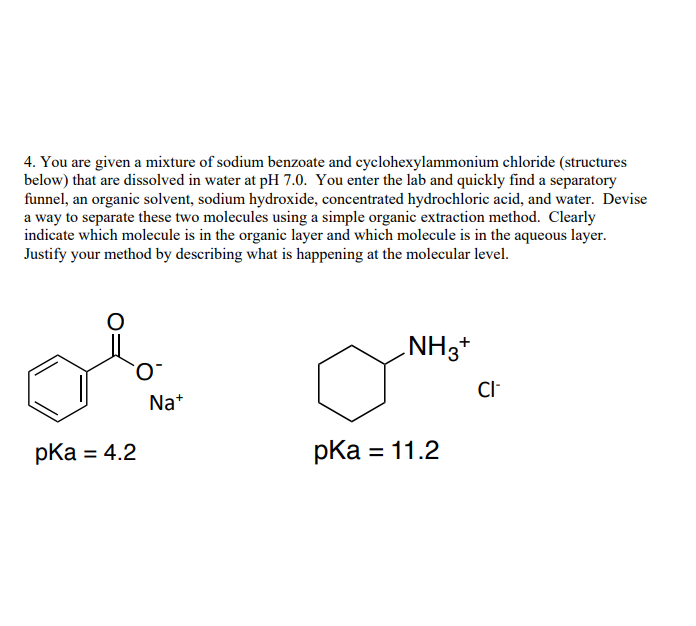4. You are given a mixture of sodium benzoate and cyclohexylammonium chloride (structures below) that are dissolved in water at pH 7.0. You enter the lab and quickly find a separatory funnel, an organic solvent, sodium hydroxide, concentrated hydrochloric acid, and water. Devise a way to separate these two molecules using a simple organic extraction method. Clearly indicate which molecule is in the organic layer and which molecule is in the aqueous layer. Justify your method by describing what is happening at the molecular level.
4. You are given a mixture of sodium benzoate and cyclohexylammonium chloride (structures below) that are dissolved in water at pH 7.0. You enter the lab and quickly find a separatory funnel, an organic solvent, sodium hydroxide, concentrated hydrochloric acid, and water. Devise a way to separate these two molecules using a simple organic extraction method. Clearly indicate which molecule is in the organic layer and which molecule is in the aqueous layer. Justify your method by describing what is happening at the molecular level.
Chemistry
10th Edition
ISBN:9781305957404
Author:Steven S. Zumdahl, Susan A. Zumdahl, Donald J. DeCoste
Publisher:Steven S. Zumdahl, Susan A. Zumdahl, Donald J. DeCoste
Chapter1: Chemical Foundations
Section: Chapter Questions
Problem 1RQ: Define and explain the differences between the following terms. a. law and theory b. theory and...
Related questions
Question

Transcribed Image Text:4. You are given a mixture of sodium benzoate and cyclohexylammonium chloride (structures
below) that are dissolved in water at pH 7.0. You enter the lab and quickly find a separatory
funnel, an organic solvent, sodium hydroxide, concentrated hydrochloric acid, and water. Devise
a way to separate these two molecules using a simple organic extraction method. Clearly
indicate which molecule is in the organic layer and which molecule is in the aqueous layer.
Justify your method by describing what is happening at the molecular level.
NH3*
Cl-
Na+
pka = 4.2
pka = 11.2
%3D
Expert Solution
This question has been solved!
Explore an expertly crafted, step-by-step solution for a thorough understanding of key concepts.
Step by step
Solved in 2 steps

Knowledge Booster
Learn more about
Need a deep-dive on the concept behind this application? Look no further. Learn more about this topic, chemistry and related others by exploring similar questions and additional content below.Recommended textbooks for you

Chemistry
Chemistry
ISBN:
9781305957404
Author:
Steven S. Zumdahl, Susan A. Zumdahl, Donald J. DeCoste
Publisher:
Cengage Learning

Chemistry
Chemistry
ISBN:
9781259911156
Author:
Raymond Chang Dr., Jason Overby Professor
Publisher:
McGraw-Hill Education

Principles of Instrumental Analysis
Chemistry
ISBN:
9781305577213
Author:
Douglas A. Skoog, F. James Holler, Stanley R. Crouch
Publisher:
Cengage Learning

Chemistry
Chemistry
ISBN:
9781305957404
Author:
Steven S. Zumdahl, Susan A. Zumdahl, Donald J. DeCoste
Publisher:
Cengage Learning

Chemistry
Chemistry
ISBN:
9781259911156
Author:
Raymond Chang Dr., Jason Overby Professor
Publisher:
McGraw-Hill Education

Principles of Instrumental Analysis
Chemistry
ISBN:
9781305577213
Author:
Douglas A. Skoog, F. James Holler, Stanley R. Crouch
Publisher:
Cengage Learning

Organic Chemistry
Chemistry
ISBN:
9780078021558
Author:
Janice Gorzynski Smith Dr.
Publisher:
McGraw-Hill Education

Chemistry: Principles and Reactions
Chemistry
ISBN:
9781305079373
Author:
William L. Masterton, Cecile N. Hurley
Publisher:
Cengage Learning

Elementary Principles of Chemical Processes, Bind…
Chemistry
ISBN:
9781118431221
Author:
Richard M. Felder, Ronald W. Rousseau, Lisa G. Bullard
Publisher:
WILEY